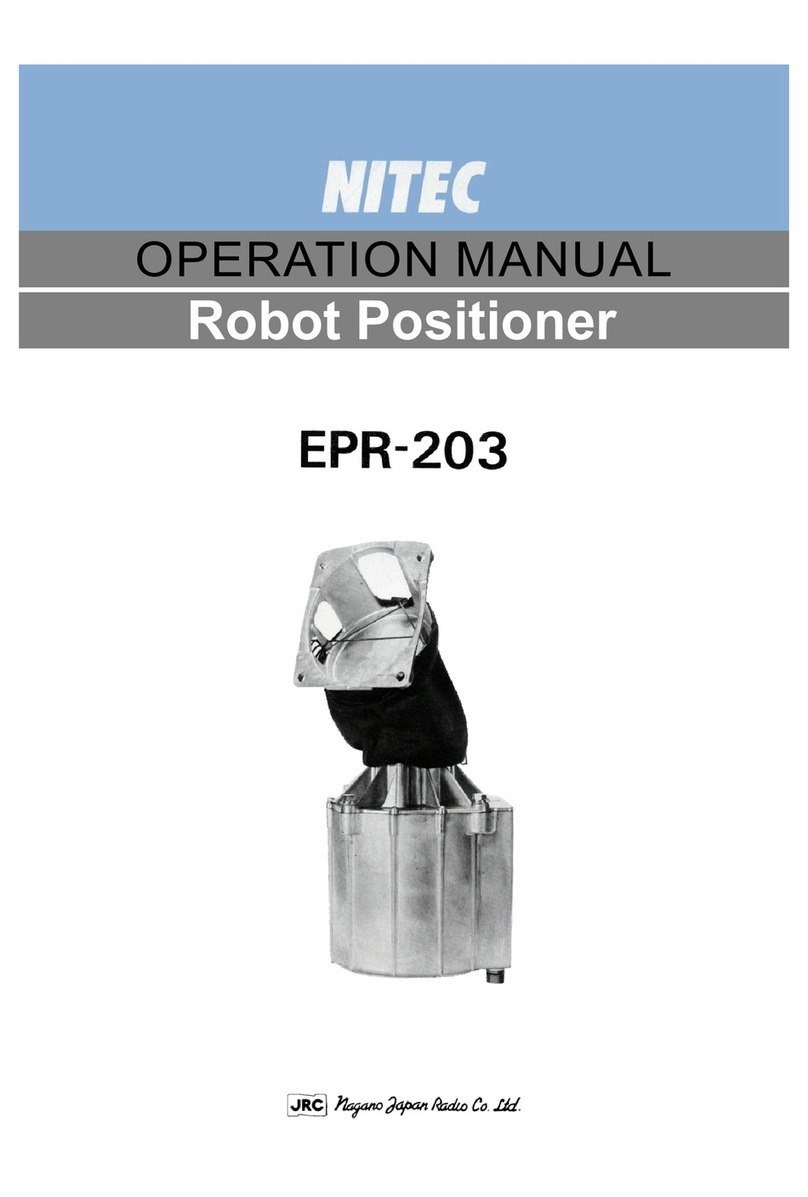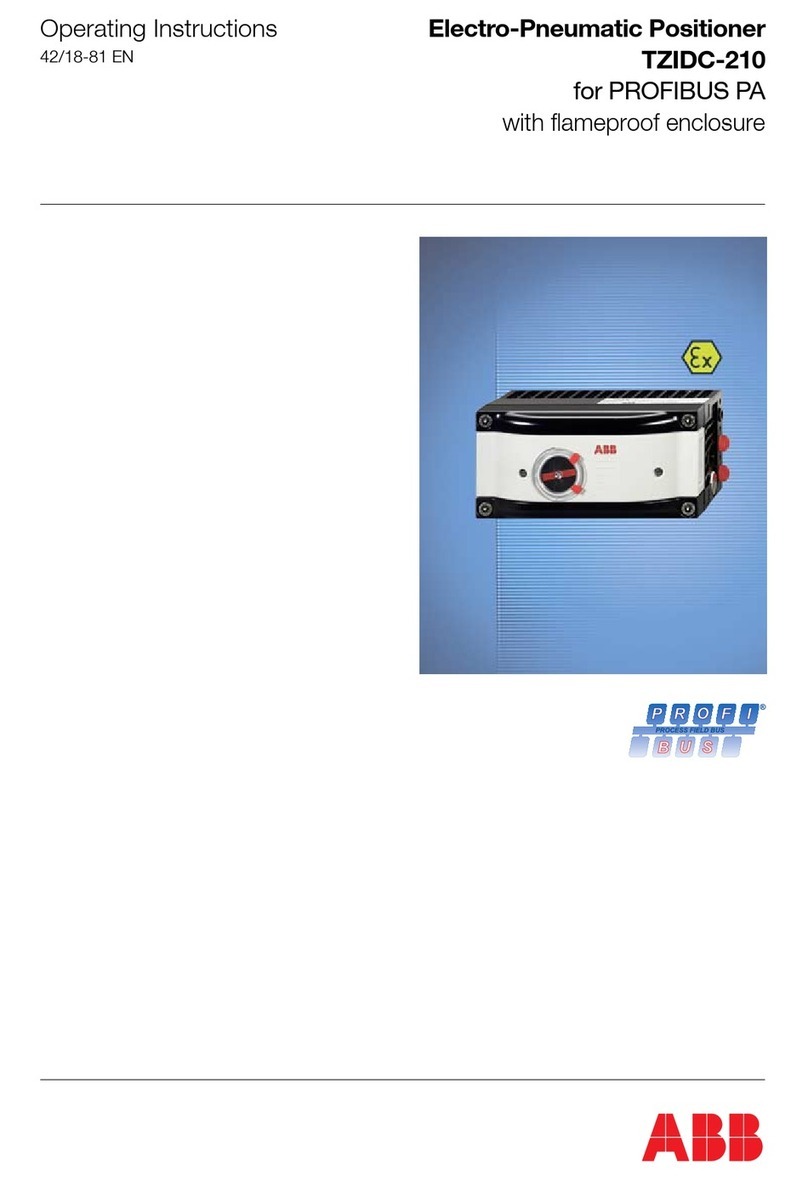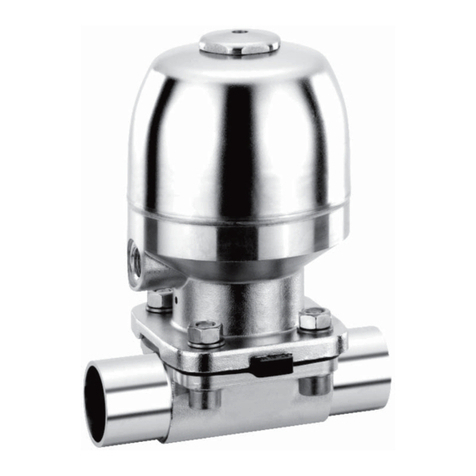Infranor SMT-BD2/m User manual

1
SMT-BD2/m
SMT-BD2/m
gb
POSITIONER
FOR SINUSOIDAL
BRUSHLESS LINEAR AND
ROTATING AC MOTORS

2
SMT-BD2/m
WARNING
This is a general manual describing a series of servo amplifiers having output capability suitable for driving AC
brushless sinusoidal servo motors.
Instructions for storage, use after storage, commissioning as well as all technical details require the MANDATORY
reading of the manual before getting the amplifiers operational.
Maintenance procedures should be attempted only by highly skilled technicians having good knowledge
of electronics and servo systems with variable speed (EN 60204-1 standard) and using proper test
equipment.
The conformity with the standards and the "CE" approval is only valid if the items are installed according to the
recommendations of the amplifier manuals. Connections are the user's responsibility if recommendations and
drawings requirements are not met.
INFRANOR does not assume any responsibility for any physical or material damage due to improper handling or
wrong descriptions of the ordered items.
Any intervention on the items, which is not specified in the manual, will immediately cancel the warranty.
Infranor reserves the right to change any information contained in this manual without notice.
© INFRANOR, November 2007. All rights reserved.
Issue: 2.2
!
Any contact with electrical parts, even after power down, may involve physical damage.
Wait for at least 5 minutes after power down before handling the amplifiers (a residual voltage of several
hundreds of volts may remain during a few minutes).
ESD INFORMATION (ElectroStatic Discharge)
INFRANOR amplifiers are conceived to be best protected against electrostatic discharges. However,
some components are particularly sensitive and may be damaged if the amplifiers are not properly
stored and handled.
STORAGE
- The amplifiers must be stored in their original package.
- When taken out of their package, they must be stored positioned on one of their flat metal
surfaces and on a dissipating or electrostatically neutral support.
- Avoid any contact between the amplifier connectors and material with electrostatic potential
(plastic film, polyester, carpet…).
HANDLING
- If no protection equipment is available (dissipating shoes or bracelets), the amplifiers must
be handled via their metal housing.
- Never get in contact with the connectors.
ELIMINATION
In order to comply with the 2002/96/EC directive of the European Parliament and of the Council of
27 January 2003 on waste electrical and electronic equipment (WEEE), all INFRANOR devices
have got a sticker symbolizing a crossed-out wheel dustbin as shown in Appendix IV of the
2002/96/EC Directive.
This symbol indicates that INFRANOR devices must be eliminated by selective disposal and not
with standard waste.

3
SMT-BD2/m
Content
s
CONTENTS
CONTENTS............................................................................................................................................. 3
CHAPTER 1 - GENERAL DESCRIPTION ............................................................................................. 7
1-INTRODUCTION............................................................................................................................ 7
2-GENERAL DESCRIPTION............................................................................................................. 7
3-REFERENCE TO THE STANDARDS............................................................................................ 8
4-REFERENCE TO OTHER DOCUMENTS...................................................................................... 8
CHAPTER 2 - SPECIFICATIONS .......................................................................................................... 9
1-TECHNICAL SPECIFICATIONS.................................................................................................... 9
1.1 - Current ratings for the 220 VAC amplifier version................................................................. 9
1.2 - Current ratings for the 400 VAC amplifier version............................................................... 10
1.3 - Other specifications.............................................................................................................. 11
2-BLOCK DIAGRAM ....................................................................................................................... 13
3-MAIN PROTECTIONS ................................................................................................................. 14
3.1 - Displayed protections........................................................................................................... 14
3.2 - Fuse protection..................................................................................................................... 15
CHAPTER 3 - INPUTS - OUTPUTS.................................................................................................... 16
1-CONNECTORS LOCATION ....................................................................................................... 16
1.1 - RACK connectors................................................................................................................. 16
1.2 - Amplifier connectors............................................................................................................. 16
2-X5 SERIAL LINK CONNECTOR (SUB D9PINS MALE).................................................................. 16
3-X1 ENCODER FEEDBACK CONNECTOR (SUB D15 POINTS FEMALE)........................................ 17
3.1 - X1 connector for TTL incremental encoder configuration.................................................... 17
3.2 - X1 connector for TTL incremental encoder & HES configuration........................................ 18
3.3 - X1 connector for absolute single turn Sin/Cos encoder configuration................................. 19
3.4 - X1 connector for other Sin/Cos encoder configurations ...................................................... 20
4-X4 ANALOG INPUT &COMMAND CONNECTOR (SUB D25 PINS MALE).................................... 21
4.1 - Specification of the analog inputs / outputs.......................................................................... 22
4.2 - Specification of the logic inputs / outputs............................................................................. 22
5-X2 ENCODER OUTPUT &COMMAND CONNECTOR (SUB D25 PINS FEMALE)......................... 24
6-X6 LOGIC OUTPUTS CONNECTOR (SUB D9PINS FEMALE)....................................................... 25
7-X7 LOGIC INPUTS CONNECTOR (SUB D9PINS MALE).............................................................. 25
CHAPTER 4 - CONNECTIONS............................................................................................................ 26
1-CONNECTION DIAGRAMS......................................................................................................... 26
1.1 - Rack power supply and motor connection........................................................................... 26
1.2 - Amplifier i/o connections ...................................................................................................... 26
1.3 - RS-232 serial link connection............................................................................................... 28
2-WIRING (ACCORDING TO CEI 801 AND EN 55011 STANDARDS)...................................................... 28
2.1 - GND wiring and grounding................................................................................................... 28
2.2 - Motor and sensors cables .................................................................................................... 28
2.3 - Analog inputs and serial link cables..................................................................................... 28
3-360° SHIELD ON THE CONNECTORS....................................................................................... 29
CHAPTER 5 - ADJUSTABLE FUNCTIONS ........................................................................................ 30
1-HARDWARE ADJUSTMENTS..................................................................................................... 30
2-ADJUSTABLE PARAMETERS .................................................................................................... 31
CHAPTER 6 - COMMISSIONING......................................................................................................... 32
1-CHECKING THE AMPLIFIER CONFIGURATION....................................................................... 32
1.1 - Standard amplifier configuration ..........................................................................................32
1. 2 - Encoder configuration ......................................................................................................... 32
1. 3 - Hall EffectSensors configuration........................................................................................33

4
SMT-BD2/m
Contents
1. 4 - Motor thermal sensor configuration..................................................................................... 33
1.5 - Current loops adjustments.................................................................................................... 33
2-PUTTING INTO OPERATION...................................................................................................... 35
3-AMPLIFIER COMMISSIONING AND ADJUSTMENT.................................................................. 35
3.1 - Amplifier setup...................................................................................................................... 35
3.2 - Motor Hall EffectSensors adjustment .................................................................................. 36
3.3 - Absolute single turn Sin/Cos encoder adjustment................................................................ 36
3.4 - Amplifier parameter setting................................................................................................... 36
3.5 - Amplifier auto-tuning with an unbalanced load.................................................................... 37
3.6 - Saving of the amplifier parameters....................................................................................... 38
3.7 - Motor phasing at power up................................................................................................... 38
3.8 - Amplifier addressing ............................................................................................................. 38
3.9 - Parameters adjustment to a linear motor ............................................................................. 39
CHAPTER 7 - PROGRAMMATION......................................................................................................40
1-GENERAL DESCRIPTION........................................................................................................... 40
2-DESCRIPTION OF THE LOGIC I/OS........................................................................................... 40
2.1 - LOGIC INPUTS ................................................................................................................... 40
2.2 - LOGIC OUTPUTS ............................................................................................................... 41
3-POSITIONER PARAMETERS...................................................................................................... 42
3.1 - CONFIGURATION OF THE PROGRAMMABLES I/Os ...................................................... 42
3.2 - AXIS POSITION SCALING.................................................................................................. 42
3.3 - POSITIONER CONFIGURATION ....................................................................................... 43
3.4 - MANUAL MODE PARAMETERS........................................................................................ 44
4-EDITION OF ASEQUENCE......................................................................................................... 45
4.1 - HOMING SEQUENCE......................................................................................................... 46
4.2 - POSITIONING SEQUENCE................................................................................................ 47
4.3 - SPEED SEQUENCE ............................................................................................................47
4.4 - TORQUE SEQUENCE......................................................................................................... 48
4.5 - SEQUENCES CHAINNING.................................................................................................. 49
4.6 - PROGRAMMABLES OUTPUTS .......................................................................................... 50
4.7 - PROGRAMMABLE INPUTS................................................................................................. 51
5-PROGRAMME EXECUTION........................................................................................................ 51
6-SPEED AND TORQUE LIMITATION............................................................................................ 51
CHAPTER 8 - TROUBLESHOOTING.................................................................................................. 52
1-SYSTEM FAULT...........................................................................................................................52
2-STORED FAULTS........................................................................................................................ 52
2.1 - "BUSY" fault......................................................................................................................... 52
2.2 - "EEPROM" fault.................................................................................................................... 52
2.3 - "°C MOTOR" fault................................................................................................................. 53
2.4 - "UNDERVOLT." fault ............................................................................................................ 53
2.5 - "°C AMPLIFIER" fault ........................................................................................................... 53
2.6 - "POWER STAGE" fault......................................................................................................... 53
2.7 - "HES" fault ............................................................................................................................ 53
2.8 - "ENCODER" fault ................................................................................................................. 54
2.9 - "COUNTING" fault ................................................................................................................ 54
2.10 - "I2t" fault .............................................................................................................................. 56
2.11 - "POSITION" fault ................................................................................................................ 56
2.12 - "ADC" fault.......................................................................................................................... 56
3-OPERATING PROBLEMS ........................................................................................................... 56
3.1 - Motor supplied but no torque................................................................................................ 56
3.2 - Motor does not move............................................................................................................ 56
3.3 - Shaft locked, eratic oscillations or rotation at maximum speed ........................................... 56
3.4 - Discontinuous motor rotation with zero torque positions..................................................... 56
3.5 - Loud crackling noise in the motor at standstill...................................................................... 56
3.6 - Loud noise in the motor at standstill and when running....................................................... 56
4-SERVICE AND MAINTENANCE .................................................................................................. 57

5
SMT-BD2/m
Content
s
CHAPTER 9 - APPENDIX .................................................................................................................... 58
1-USE OF THE LIMIT SWITCHES &"CVO" INPUTS..................................................................... 58
2-USE OF THE "AMP. READY" &"POWER READY" OUTPUTS................................................... 58
3-FOLLOWING ERROR PROTECTION ......................................................................................... 58
4-I²TPROTECTION......................................................................................................................... 59
4.1 - Current limitation in Fusing mode.........................................................................................59
4.2 - Current limitation in Limiting mode.......................................................................................60
5-SERVO CONTROLLER STRUCTURE........................................................................................ 61
6-ASCII INSTRUCTIONS LIST........................................................................................................ 62
6.1 - OVERVIEW .......................................................................................................................... 62
6.2 - INSTRUCTIONS LIST.......................................................................................................... 63
7-USING ADISPLAY TERMINAL.................................................................................................... 67
7.1 - CONFIGURATION ............................................................................................................... 67
7.2 - USE ...................................................................................................................................... 67
8-AMPLIFIER TYPES...................................................................................................................... 69

6
SMT-BD2/m
___________________________________BLANK PAGE_______________________________
___________________________________BLANK PAGE_______________________________

7
CHAPTER 1 – General description
SMT-BD2/m
CHAPTER 1 - GENERAL DESCRIPTION
1 - INTRODUCTION
Series SMT-BD2/m digital servo modules are sinusoidal PWM power amplifiers that provide position, speed and
torque/force control for AC brushless motors (rotating or linear) equipped with encoder only or encoder with Hall
Effect Sensors (HES) for the position feedback.
The SMT-BD2/m digital servo drive is 220 VAC or 400 VAC main operated. The SMT-BD2/m plug-in system with
400 VAC power supply is available as a multiaxis version that can receive up to three axes in a standard 19" rack
including the power supply. The SMT-BD2/m plug-in system with 220 VAC power supply is available as a single-
axis block version or as a multiaxis version that can receive up to six axes in a standard 19" rack including the
power supply.
2 - GENERAL DESCRIPTION
Series SMT-BD2/m amplifiers have their own DC/DC converter to provide the appropriate supply voltage (+5 V,
+15 V, -15V). The source supply voltage for the logic board is the auxiliary 310 VDC supply voltage. The auxiliary
supply voltage allows to have the axis position value still available when the power supply voltage is turned off.
Each module is packaged as a 6 U "double Eurocard":
- one power board with IGBT transistors
- one logic board with DSP (Digital Signal Processing).
The SMT-BD2/m amplifier directly controls the motor torque/force, speed and position by means of the
information provided by an encoder feedback device. The sinusoidal current commutation based on encoder
feedback provides smooth motor torque/force control.
The SMT-BD2/m amplifier can be configurated for various encoder feedback types. The appropriate encoder
input configuration is selectable by jumpers.
♦ With an incremental encoder only, a motor phasing procedure must be executed at each amplifier power up
before the motor enabling.
♦ With an incremental encoder + HES feedback from the motor, the motor phasing procedure is no more
necessary and the servo motor can immediately be enabled after the amplifier power up.
♦ With an absolute single turn SinCos encoder feedback from the motor (Heidenhain ERN 1085 or compatible),
the servo motor can also immediately be enabled after the amplifier power up.
The SMT-BD2/m amplifiers are suited for axis positioning applications. Up to 128 control sequences including
axis homing, absolute or relative displacement, speed profile running and torque regulation can be programmed
and combined in order to solve various applications. The sequence chaining capability allows to define macro-
sequences for complex applications: several control sequences can be linked together in order to be automatically
executed one after the other. The control sequences are pre-programmed. So, the application programmation
simply consists in initializing the sequences parameters with the desired values. A control sequence can then be
selected by using the programmable logic inputs activation and its execution is started by using the START logic
input. The SMT-BD2/m amplifiers can operate in stand alone or in connection with a host controller (PC or PLC).
The motor position output is available as two A and B encoder type channels in quadrature, and one Z marker
pulse per revolution via RS422 line drivers. The ratio between the number of pulses on the motor encoder and the
number of pulses on the SMT-BD2/m amplifier encoder output is programmable.
The amplifier faults are displayed on the front panel and can also be read via the serial link.
All control parameters are programmable by means of the serial link and saved in an EEPROM. The auto-
configuration and auto-tuning functions allow an easy and quick commissioning of the amplifier.
The Visual Drive Setup software, which is IBM-PC compatible with the WINDOWS® operating system, makes
the amplifier commissioning and the application programmation easier. The Visual Drive Setup software also
includes a digitizing oscilloscope function that is particularly useful for the drive commissioning and maintenance.

8 CHAPTER 1 – General description
SMT-BD2/m
3 - REFERENCE TO THE STANDARDS
The 220 VAC version of the SMT-BD2/m amplifiers operating in the BF rack, which is equipped with the mains
filter BF-35 or 70, has been approved for its conformity with the Electromagnetic Compatibility standards:
• EN 55011, Group 1, Class A regarding the conducted and radiated radioelectric disturbances,
• CEI 801 - 2 - 3 - 4 regarding the immunity.
The 400 VAC version of the SMT-BD2/m amplifiers operating in the BF-400 rack, which is equipped with the
mains filter F400-35 or 70, has been approved for its conformity with the Electromagnetic Compatibility standards:
• EN 55011, Group 1, Class A regarding the conducted and radiated radioelectric disturbances,
• CEI 801 - 2 - 3 - 4 regarding the immunity.
Standard to be applied to the electrical equipments of industrial machines: EN 60204.1.
The SMT-BD2/m amplifiers have been "CE" marked since year 2002.
4 - REFERENCE TO OTHER DOCUMENTS
♦BF-400 rack – for the use of the 400 VAC amplifier version in a multiaxis rack.
♦BF rack – for the use of the 220VAC amplifier version in a multiaxis rack.
♦BM20A/BMM05F/05AF single-axis rack – for the use of the 220 VAC amplifier version in a single-axis rack.

9
CHAPTER 2 – Specifications
SMT-BD2/m
CHAPTER 2 - SPECIFICATIONS
1 - TECHNICAL SPECIFICATIONS
1.1 -CURRENT RATINGS FOR THE 220 VAC AMPLIFIER VERSION
Operating voltage DC bus 310 VDC (270 VDC < DC bus < 340 VDC max.)
Auxiliary supply voltage 310 VDC ( 200 VDC < Uaux < 340 VDC max.)
Motor terminal to terminal output voltage 200 Vrms for 310 VDC bus
Authorized output currents for current pulse mode operation (I2t protection in fusing mode)
AMPLIFIER
U rated
Imax (A rms)
Max. authorized rated current (Arms)
of the amplifier
(Vrms) 1 s WITHOUT
FAN*
FAN TYPE
1*
FAN TYPE
2*
SMT-BD2/m - 220/04 240 4,4 2
SMT-BD2/m - 220/08 240 8,8 4
SMT-BD2/m - 220/12 240 13,8 6
SMT-BD2/m - 220/17 240 17,7 8,5
SMT-BD2/m - 220/30 240 30,8 10 12 15
SMT-BD2/m - 220/30r 240 30,8 10 15
SMT-BD2/m - 220/45 240 48,6 10 15 20
SMT-BD2/m - 220/45r 240 48,6 10 20 23
SMT-BD2/m - 220/60 240 61 10 19 25
SMT-BD2/m - 220/60r 240 61 12 26 30
SMT-BD2/m - 220/70 240 70 25 30 35
SMT-BD2/m - 220/100 240 100 25 30 35
Authorized output currents for continuous current mode operation (I2t protection in limiting mode)
AMPLIFIER TYPE
U rated
Imax (A rms)
Max. authorized continuous current (Arms) of
the amplifier
(Vrms) 1 s WITHOUT
FAN*
FAN TYPE
1*
FAN TYPE
2*
SMT-BD2/m - 220/04 240 4,4 2
SMT-BD2/m - 220/08 240 8,8 4
SMT-BD2/m - 220/12 240 13,8 6
SMT-BD2/m - 220/17 240 17,7 8,5 8,5
SMT-BD2/m - 220/30 240 30,8 8,5 12 15
SMT-BD2/m - 220/30r 240 30,8 10 15
SMT-BD2/m - 220/45 240 48,6 8,5 15 18
SMT-BD2/m - 220/45r 240 48,6 10 20 23
SMT-BD2/m - 220/60 240 61 8,5 17 20
SMT-BD2/m - 220/60r 240 61 12 26 30
SMT-BD2/m - 220/70 240 70 17 30 35
SMT-BD2/m - 220/100 240 100 25 30 35
* Maximum ambient temperature = + 40° C, fan 1 = 56 l/s, fan 2 = 90 l/s.
Note: The SMT-BD2/m-X/Xr amplifier types are equipped with an additional heatsink in order to improve the heat
dissipation and increase their rated current. The width of these amplifier types is then 18 TE instead of 12 TE.
Minimum inductance between phases 1 mH

10 CHAPTER 2 – Specifications
SMT-BD2/m
Conformity with the standards: CE approval - EMC standards
with multiaxis power supply configuration Immunity: CEI standards 801- 2 - 3 - 4
BF rack and mains filter BF-35 or 70, Conducted and radiated disturbances: EN 55011,
or SMTB.M 20 A single-axis rack and BF 35 filter. Group 1, class A
"360°" shields; equipotential according to the - Electrical standards for industrial machines:
wiring rules. EN 60204.1: - Insulator: 1500 VAC/1 min.
- Leakage current > 3 mA
(EMI filters)
Temperature range * storage - 20°C to + 70°C
* operation 5°C to +40°C
From 40°C on, the rated currents
must be reduced of 3 %/°C.
Max. temperature: 50°C
1.2 -CURRENT RATINGS FOR THE 400 VAC AMPLIFIER VERSION
Operating voltage DC bus 565 VDC (480 VDC < DC bus < 685 VDC
max.)
Auxiliary supply voltage 310 VDC (200 VDC < Uaux < 340 VDC max.)
Motor terminal to terminal output voltage 380Vrms for 565 VDC bus
Authorized output currents for current pulse mode operation (I2t protection in fusing mode)
AMPLIFIER
U rated
Imax (A rms)
Max. authorized rated current
(Arms) of the amplifier
(Vrms) 1 s WITHOUT
FAN*
FAN TYPE
2*
SMT-BD2/m - 400/15 400 15.5 5 7.5
SMT-BD2/m - 400/30 400 30 8 15
SMT-BD2/m - 400/45 400 48 10 19
SMT-BD2/m - 400/60 400 60 not used 28
SMT-BD2/m - 400/100 400 100 not used 35
Authorized output currents for continuous current mode operation (I2t protection in limiting mode)
AMPLIFIER TYPE
U rated
Imax (A rms)
Max. authorized continuous
current (Arms) of the amplifier
(Vrms) 1 s WITHOUT
FAN*
FAN TYPE
2*
SMT-BD2/m - 400/15 400 15.5 not used 5
SMT-BD2/m - 400/30 400 30 not used 10
SMT-BD2/m - 400/45 400 48 not used 15
SMT-BD2/m - 400/60 400 60 not used 23
SMT-BD2/m - 400/100 400 100 not used 28
* Maximum ambient temperature = + 40° C, fan 2 = 90 l/s.
Minimum inductance between phases 2 mH
Conformity with the standards: CE approval - EMC standards
with multiaxis power supply configuration Immunity: CEI standards 801- 2 - 3 - 4
BF-400 rack and mains filter F400-35 or 70. Conducted and radiated disturbances: EN 55011,
"360°" shields; equipotential according to the Group 1, class A
wiring rules. - Electrical standards for industrial machines:
EN 60204.1: - Insulator: 2500 VDC/1 min.
- Leakage current > 3 mA
(EMI filters without capacitors)
Temperature range * storage - 20°C to + 70°C
* operation 5°C to +40°C
From 40°C on, the rated currents
must be reduced of 3 %/°C.
Max. temperature: 50°C

11
CHAPTER 2 - Specifications
SMT-BD2/m
1.3 -OTHER SPECIFICATIONS
PWM switching frequency 10 kHz
Current regulator (PI) Adjusted to motor
Current loop bandwidth Cut-off frequency for 45° phase shift > 1 kHz
Internal current limitation Maximum current range : 20 % to 100 % of Imax
Rated current range : 20 % to 50 % of Imax
Imax = amplifier current rating
Analog torque limitation input 0 V to 10 V, resolution = 12 bits
100 % to 0 % of the torque set point value
No limitation for 0 Volt
Analog speed limitation input ±10 V, standard resolution = 12 bits
100 % to 0.1 % of the maximum speed value
Speed and position regulator Sampling period = 0,5 ms
Anti-wind-upsystem of the integrator
Adjustable digital gains
Antiresonance filter
Servo loop bandwidth Cut-off frequency for 45° phase shift
Selectable : 50 Hz, 75 Hz or 100 Hz
(see Note 1)
Max. motor speed Adjustable from 100 rpm to 25000 rpm
(see Note 2)
Encoder input Selectable by jumpers :
Quadrature and TTL A & B signals with Z marker
pulse
RS 422 line receiver
maximum pulses frequency: 500 kHz
Resolution:10
3to 106ppr
Incremental Sin/Cos encoder
Heidenhain 1Vcc Sin/Cos type or compatible
maximum signal frequency: 500 kHz
Resolution: 500 to 106ppr
Interpolation factor : 1024
Absolute single turn Sin/Cos encoder
Heidenhain ERN 1085 or compatible
maximum signal frequency: 200 kHz
resolution: 2048 ppr or 512 ppr
Interpolation factor : 1024
Note 1:
The maximum servo loop bandwidth value not only depends on the amplifier specification but also on the encoder resolution
and the mechanical motor load. The lower the encoder resolution, the lower the servo loop gains and the servo loop bandwidth,
to avoid any motor noise due to signal quantization effect. However when the “pulse interpolation” mode is activated with a
Sin/Cos encoder type, the servo loop bandwidth can be dramatically increased because the internal position resolution is equal
to the encoder resolution value multiplied by the interpolation factor (1024). The mechanical load backlashes and elasticity can
also limit the servo loop gains and bandwidth to avoid mechanical resonances. The optimal servo loop gain value for a given
application can be automatically calculated by using the amplifier Auto-tuning procedure.
Note 2:
The Max. motor speed value not only depends on the motor specification but also on the encoder specification. Both following
conditions must be answered for taking into account the maximum encoder pulse frequency value :
Max. motor speed (rpm) < 60 x 106 / Number of encoder pulses per revolution
Max. motor speed (rpm) < 60 x Encoder pulse frequency limit (Hz) / Number of encoder pulses per revolution
For example with the ROD426 (Heidenhain) series encoder, the pulse frequency limit value is 300 kHz. So, a motor equipped
with a ROD426 encoder having a resolution of 5000 ppr cannot exceed 3600 rpm.

12 CHAPTER 2 – Specifications
SMT-BD2/m
Hall sensors input Selectable by jumpers : 120° or 60° HES type
5 V or 15 V supply voltage
HES sequence error detection
Encoder output Quadrature and TTL A & B signals with Z marker
pulse
RS 422 line driver
Programmable encoder division ratio
output resolution / input resolution : 1, 1/2, 1/4, 1/8
Dedicated logic inputs Optoisolated, positive logic,
response time = 0.5 ms :
•Enable/Disable: ENABLE
•Servo On/Off: RUN
•Homingswitch:INDEX
•Limitswitch+:FC+
•Limitswitch-:FC-
•Sequence start: START
•Sequence stop: STOP
•Sequence wait: WAIT
•Sequence teach: TEACH
•Jog positive direction: JOG+
•Jog negative direction: JOG-
Amplifier fault reset: RESET
Programmable logic inputs Optoisolated, positive logic :
IN1toIN8
Dedicated logic outputs Relay contact Umax = 60 V,
Imax = 200 mA, Pmax = 10 W :
• "Power ready": closed if power OK
• "Amp ready": closed if amplifier OK
• "Phasing OK": closed if motor phasing OK
• "Brake": closed to desactivate the motor brake
Optoisolated:
•Sequence execution: SEQ
•Position reached: POS
•Speed reached: SPEED
•Motor enabled: OK
Programmable logic outputs Optoisolated :
OUT1 to OUT8
Monitor outputs 2 channels ANout1 & ANout2
+/-10 V full scale, 12 bit resolution
Programmable output signals on the
digitizing
oscilloscope Channel 1 and Channel 2 :
current ref (IDC), current mes (ID,IQ,IMES,I2t),
speed ref (CV), speed mes (GT)
Error display LEDs on front panel and diagnostic via serial link
Parameter setting Serial link RS232 in standard or RS422 optional
Automatic functions Motor parameters adjustment (Auto-phasing)
Regulator gains adjustment (Auto-tuning)
Altitude 1000 m
Moisture < 50 % at 40°C and < 90 % at 20°C
no condensation
(EN 60204.1 standard)
Cooling Natural convection or forced air, according to the
ratedcurrent(see current tables).

13
CHAPTER 2 – Specifications
SMT-BD2/m
2 - BLOCK DIAGRAM
The SMT-BD2/m servo module block diagram is presented below.
A
B
Z
A
B
Z
X1
X2
X6
X5
+5 V
+15 V
-15 V
U
V
W
PR
10
PR
8
310 V DC
X7
X4
Drive
protections
Encoder
input
Encoder
divider
Sequences
controller
Serial
link
Position Ref
Position
Supply
voltages
Position
Pulses
counter
Position
controller
Drive
parameters
Vector
control
Current Ref
Current
limitation
Current
loops
PWM
power stage
Current Mes
Motor phases
Power
supply
Aux. supply
OUTPUTS
INPUTS
SPEED LIMIT
TORQUE LIMIT
Current
Limit
The PR8 and PR10 connectors are not accessible for direct wiring; they are plugged on the BM20A single-axis
rack or on the multiaxis BF rack according to the SMT-BD2/m amplifier housing (see chapter 3).

14 CHAPTER 2 – Specifications
SMT-BD2/m
3 - MAIN PROTECTIONS
3.1 -DISPLAYED PROTECTIONS
PROTECTION ERROR DISPLAY LED*
Amplifier rated current overload I2t 5z
. blinking display = I2t warning threshold is reached (Idyn output) zz
. continuous display = I2t fault (amplifier inhibited in fusing mode)
Encoder cable interruption Encoder z5
zz
Encoder pulses counting error Counting 55
z5
Power stage failure: Power stage 55
. power supply overvoltage zz
. internal overcurrent protection
. short-circuit between phases
. amplifier overtemperature
(220/04 to 220/60 current ratings and 400 VAC amplifier range)
Amplifier overtemperature °C Amp 5z
(only 220/70 and 220/100 current rating amplifiers) 5z
Power supply undervoltage Undervolt. z5
5z
Motor overtemperature °C Motor 55
5z
Hall Effect Sensors or Sin/Cos commutation channels error HES zz
5z
Analog to Digital Conversion error ADC 5z
z5
Position following error Position zz
z5
Fault of the amplifier parameter or sequences storage EEPROM 5z
55
Amplifier automatic procedure: Busy 55
. blinking display = procedure operating 55
. continuous display = operating error
* z= LED is unlit 5= LED is lit.
All these faults are memory stored in the amplifier except for the "Undervolt." fault.
The reset of a stored fault can be made:
- by means of the RESET function in the Visual Drive Setup software
- via the fault RESET input (pin 13 of the X4 connector)
- by switching off the amplifier power supply.

15
CHAPTER 2 – Specifications
SMT-BD2/m
3.2 -FUSE PROTECTION
3.2.1 - Fuse protection for the 220 VAC amplifier version
F1 : Control of the average DC current of the power board supply (see Hardware adjustments in chapter 5).
F2 : Control of the average DC current of the logic board supply (see Hardware adjustments in chapter 5).
AMPLIFIER TYPE F1 F2
Power Logic
SMTBD2/m-220/04 to 12 10 AT 1 A
SMTBD2/m-220/17 and 30 15 AT 1 A
SMTBD2/m-220/45 20 AT 1 A
SMTBD2/m-220/60 20 AT 1 A
SMTBD2/m-220/70 - 1 A
SMTBD2/m-220/100 - 1 A
3.2.2 - Fuse protection for the 400 VAC amplifier version
F2 : Control of the average DC current of the logic board supply (see Hardware adjustments in chapter 5).
AMPLIFIER TYPE F2
Logic
SMT-BD2/m - 400/15 1 A
SMT-BD2/m - 400/30 1 A
SMT-BD2/m - 400/45 1 A
SMT-BD2/m - 400/60 1 A
SMT-BD2/m - 400/100 1 A

16 CHAPTER 3 – Inputs - Outputs
SMT-BD2/m
CHAPTER 3 - INPUTS - OUTPUTS
1 - CONNECTORS LOCATION
1.1 -RACK CONNECTORS
For the 400 VAC amplifier version, see BF-400 RACK manual.
For the 220 VAC amplifier version, see SMTB.M 20 A SINGLE-AXIS RACK manual or BF RACK manual.
1.2 -AMPLIFIER CONNECTORS
X1
X5
X2
X4
X6
X7
LED
B.P.
Faults display
Encoder sensor
Serial link
Command
Encoder output
Command
Analog inputs
Offset
Inputs
Outputs
2 - X5 SERIAL LINK CONNECTOR (Sub D 9 pins male)
PIN FUNCTION REMARKS
5 0 Volt GND (shield connection if no "360°" connection possible on the connector)
3 TXD Transmit data RS-232
2 RXD Receive data RS-232
6 TXH Transmit data RS-422
7 TXL Transmit data RS-422
8 RXL Receive data RS-422
9 RXH Receive data RS-422

17
CHAPTER 3 – Inputs - Outputs
SMT-BD2/m
3 - X1 ENCODER FEEDBACK CONNECTOR (Sub D 15 points female)
3.1 –X1 CONNECTOR FOR TTL INCREMENTAL ENCODER CONFIGURATION
The "TTL incremental encoder" configuration is selected according to the following COM and COD jumpers
setting (see chapter 5, section 1: Hardware adjustments).
The corresponding X1 connector pin function is described below.
PIN FUNCTION REMARKS
1 Marker Z/ Differential input of the encoder marker pulse Z/
9 Marker Z Differential input of the encoder marker pulse Z
2 Channel A/ Differential input of the encoder channel A/
10 Channel A Differential input of the encoder channel A
3 Channel B/ Differential input of the encoder channel B/
11 Channel B Differential input of the encoder channel B
5 +5V Encoder supply voltage (400 mA max. current)
4 GND Encoder supply GND
12 TC Motor thermal sensor input (10 mA max. load current)
13 GND Motor thermal sensor GND
6,7,8 reserved
14,15 reserved
Encoder input specification
Thermal sensor input specification
COM
COD
B2
B1
B5
B4
B3
X1-9,10,11
SMT-BD2/m
26LS32
X1-1,2,3
+5V
+5V
200R
200R
3.3K COD jumpers configuration
COD
B2
B1
ZM
ZM
Marker pulse enabled
Marker pulse disabled
ZM jumper configuration
X1-12
SMT-BD2/m
X1-13
+15V
+15V
100K
100nF
PSTH-A
MN OP
PTC thermal sensor
MN & OP jumpers configuration
MN OP NTC thermal sensor
PSTH-B
10K
+5V
A wrong jumper configuration may damage the
encoder and amplifier electronics.
!
Recommended driver:
26LS31

18 CHAPTER 3 – Inputs - Outputs
SMT-BD2/m
3.2 –X1 CONNECTOR FOR TTL INCREMENTAL ENCODER &HES CONFIGURATION
The “ TTL incremental encoder & HES” configuration is selected according to the following COM and COD
jumpers setting (see chapter 5, section 1: Hardware adjustments).
The corresponding X1 connector pin function is described below.
PIN FUNCTION REMARKS
1 Marker Z/ Differential input of the encoder marker pulse Z/
9 Marker Z Differential input of the encoder marker pulse Z
2 Channel A/ Differential input of the encoder channel A/
10 Channel A Differential input of the encoder channel A
3 Channel B/ Differential input of the encoder channel B/
11 Channel B Differential input of the encoder channel B
5 +5V Encoder supply voltage (400 mA max. current)
4 GND Encoder supply GND
14 HALL U Hall sensor input signal phase U
6 HALL V Hall sensor input signal phase V
7 HALL W Hall sensor input signal phase W
15 +15V Hall sensors supply voltage (50 mA max. current)
12 TC Motor thermal sensor input (10 mA max. load current)
13 GND Hall sensors/Thermal sensor GND
8 reserved
Encoder input specification
Specification of the Hall sensors input
60° type HES
COM
COD
B2
B1
B5
B4
B3 120° type HES
COM
COD
B2
B1
B5
B4
B3
X1-9,10,11
SMT-BD2/m
26LS32
X1-1,2,3
+5V
+5V
200R
200R
3.3K COD jumpers configuration
COD
B2
B1
ZM
ZM
Marker pulse enabled
Marker pulse disabled
ZM jumper configuration
X1-6,7,14
SMT-BD2/m
1K
X1-13
10K
1nF
+5V
74HC14
COM jumpers configuration
COM
COM
B5
B4
B3
60° HES
120° HES
B5
B4
B3
A wrong jumper configuration may damage the encoder and amplifier electronics.
!
Recommended driver:
26LS31

19
CHAPTER 3 – Inputs - Outputs
SMT-BD2/m
3.3 –X1 CONNECTOR FOR ABSOLUTE SINGLE TURN SIN/COS ENCODER CONFIGURATION
The “ Absolute single turn Sin/Cos encoder ” configuration (Heidenhain ERN 1085 or compatible) is selected
according to the following COM and COD jumpers setting (see chapter 5, section 1: Hardware adjustments).
The corresponding X1 connector pin function description is given below.
PIN FUNCTION REMARKS
1 Reference R/ Differential input of the Sin/Cos encoder reference pulse R/
9 Reference R Differential input of the Sin/Cos encoder reference pulse R
2 Channel A/ Differential input of the Sin/Cos encoder channel A/
10 Channel A Differential input of the Sin/Cos encoder channel A
3 Channel B/ Differential input of the Sin/Cos encoder channel B/
11 Channel B Differential input of the Sin/Cos encoder channel B
6 Channel C/ Differential input of the Sin/Cos encoder channel C/
14 Channel C Differential input of the Sin/Cos encoder channel C
8 Channel D/ Differential input of the Sin/Cos encoder channel D/
7 Channel D Differential input of the Sin/Cos encoder channel D
5 +5V Sin/Cos encoder supply voltage (400 mA max. current)
4 GND Sin/Cos encoder supply GND
12 TC Motor thermal sensor input (10 mA max. load current)
13 GND Motor thermal sensor GND
15 reserved
Specification of the Sin/Cos encoder channels
Specification of the Sin/Cos commutation channels
Remark: The Sin/cos encoder interpolation mode is activated by selecting the “pulse interpolation” configuration
during the amplifier parameter setting.
COM
B5
B4
B3
X1-14,7
SMT-BD2/m
X1-6,8
10K
1K 10K
50K
COM jumpers configuration
50K
X1-9,10,11
SMT-BD2/m
X1-1,2,3
10K
120R 10K
100K
COD jumpers configuration
COD
B2
B1
ZM
ZM
Marker pulse enabled
Marker pulse disabled
ZM jumper configuration
100K
COM
COD
B2
B1
B5
B4
B3
A wrong jumper configuration may damage the
encoder and amplifier electronics.
!

20 CHAPTER 3 – Inputs - Outputs
SMT-BD2/m
3.4 –X1 CONNECTOR FOR OTHER SIN/COS ENCODER CONFIGURATIONS
3.4.1) X1 connector for incremental Sin/Cos encoder configuration
The “ Incremental Sin/Cos encoder ” configuration (Heidenhain 1Vcc Sin/Cos encoder or compatible) is selected
according to the following COM and COD jumpers setting (see chapter 5, section 1: Hardware adjustments).
The corresponding X1 connector pin function description is given below.
PIN FUNCTION REMARKS
1 Reference R/ Differential input of the Sin/Cos encoder reference pulse R/
9 Reference R Differential input of the Sin/Cos encoder reference pulse R
2 Channel A/ Differential input of the Sin/Cos encoder channel A/
10 Channel A Differential input of the Sin/Cos encoder channel A
3 Channel B/ Differential input of the Sin/Cos encoder channel B/
11 Channel B Differential input of the Sin/Cos encoder channel B
5 +5V Sin/Cos encoder supply voltage (400 mA max. current)
4 GND Sin/Cos encoder supply GND
12 TC Motor thermal sensor input (10 mA max. load current)
13 GND Motor thermal sensor GND
6,7,8 reserved
14,15 reserved
The Sin/Cos channels specifications are given in section 3.3 of this chapter. The Sin/cos encoder interpolation
mode is activated by selecting the “pulse interpolation” configuration during the amplifier parameter setting.
3.4.2) X1 connector for incremental Sin/Cos encoder & HES configuration
The “ Incremental Sin/Cos encoder & HES” configuration (Heidenhain 1Vcc Sin/Cos encoder or compatible) is
selected according to the following COM and COD jumpers setting (see chapter 5, section 1: Hardware
adjustments).
The corresponding X1 connector pin function is described below.
PIN FUNCTION REMARKS
1 Reference R/ Differential input of the Sin/Cos encoder reference pulse R/
9 Reference R Differential input of the Sin/Cos encoder reference pulse R
2 Channel A/ Differential input of the Sin/Cos encoder channel A/
10 Channel A Differential input of the Sin/Cos encoder channel A
3 Channel B/ Differential input of the Sin/Cos encoder channel B/
11 Channel B Differential input of the Sin/Cos encoder channel B
5 +5V Sin/Cos encoder supply voltage (400 mA max. current)
4 GND Sin/Cos encoder supply GND
14 HALL U Hall sensor input signal phase U
6 HALL V Hall sensor input signal phase V
7 HALL W Hall sensor input signal phase W
15 +15V Hall sensors supply voltage (50 mA max. current)
12 TC Motor thermal sensor input (10 mA max. load current)
13 GND Motor thermal sensor GND
8 reserved
The Sin/Cos channels and Hall sensor inputs specifications are given in section 3.3 of this chapter. The Sin/cos
encoder interpolation mode is activated by selecting the “pulse interpolation” configuration during the amplifier
parameter setting.
COM
COD
B2
B1
B5
B4
B3
A wrong jumper configuration may damage the
encoder and amplifier electronics.
!
60° HES type
COM
COD
B2
B1
B5
B4
B3 120° HES type
COM
COD
B2
B1
B5
B4
B3
A wrong jumper configuration may damage the encoder and amplifier electronics.
!
Table of contents
Popular Valve Positioner manuals by other brands
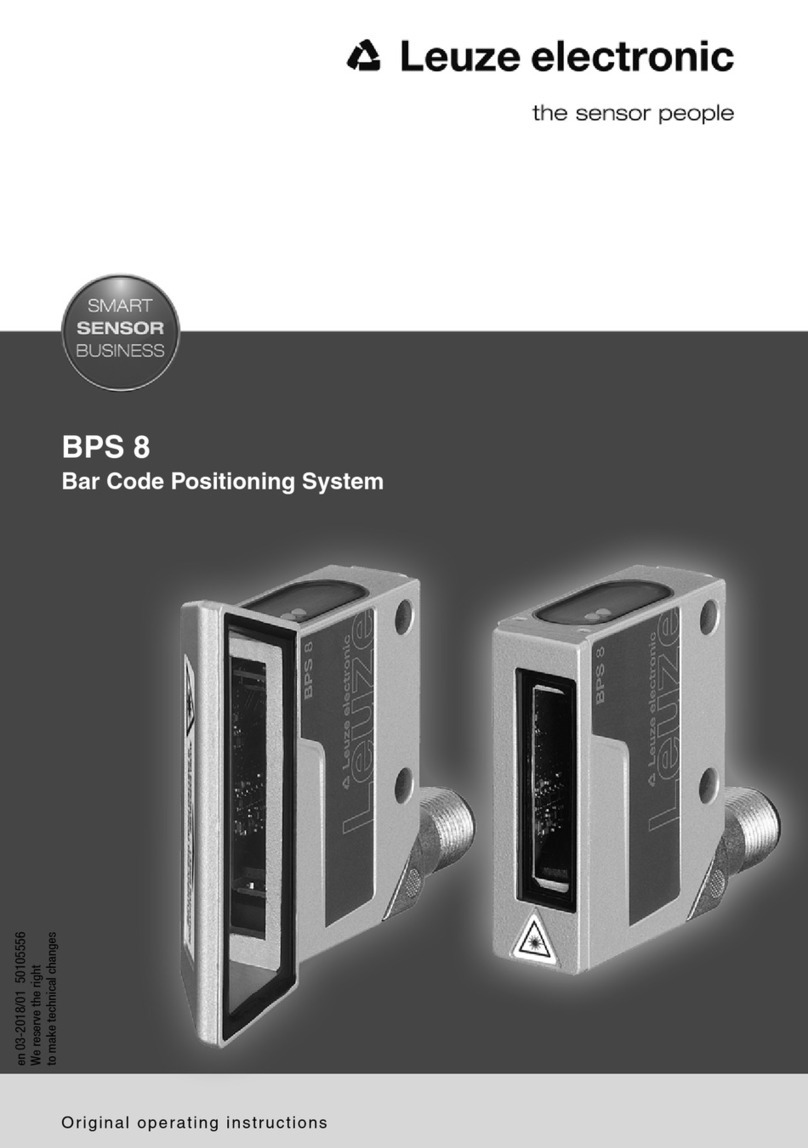
Leuze electronic
Leuze electronic BPS 8 Original operating instructions
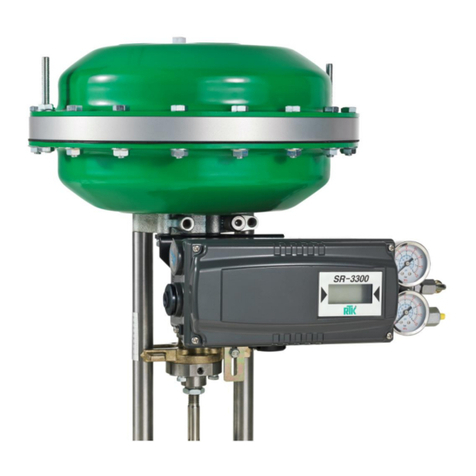
RTK
RTK SR-3300 Installation and operating instructions

Becker
Becker HPP-SB instruction manual
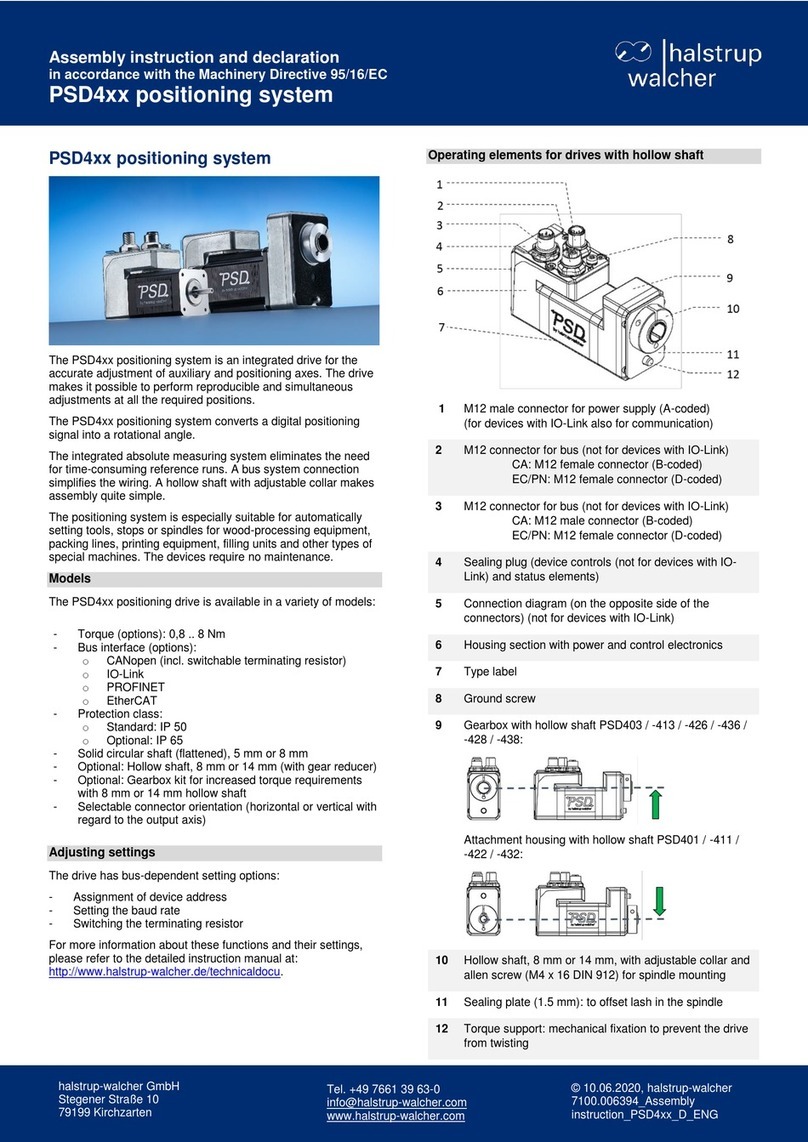
halstrup-walcher
halstrup-walcher PSD4 Series Assembly instruction and declaration
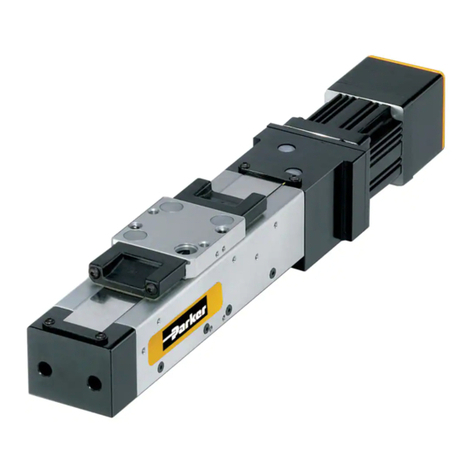
Parker
Parker 401XR Series product manual
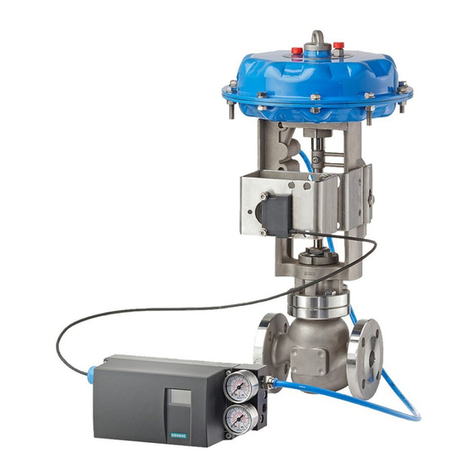
Siemens
Siemens SIPART PS2 operating instructions
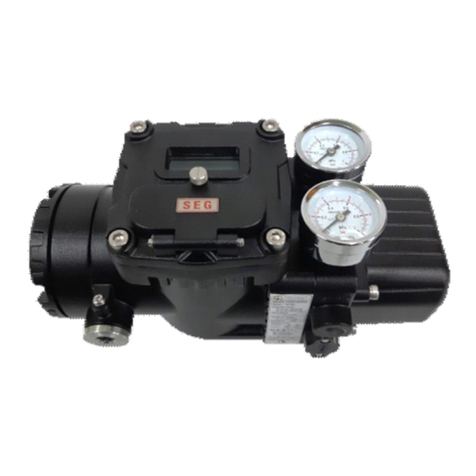
Seg
Seg SP760 Series instruction manual
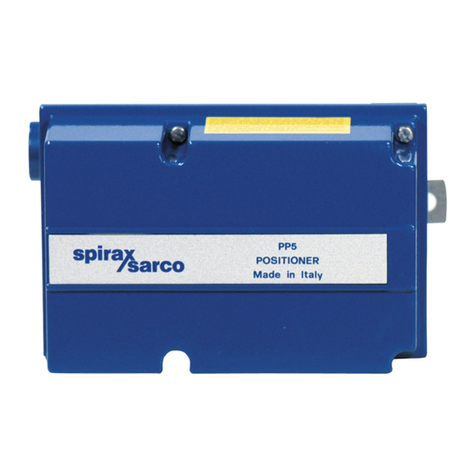
Spirax Sarco
Spirax Sarco PP 5 Series Installation and maintenance instructions
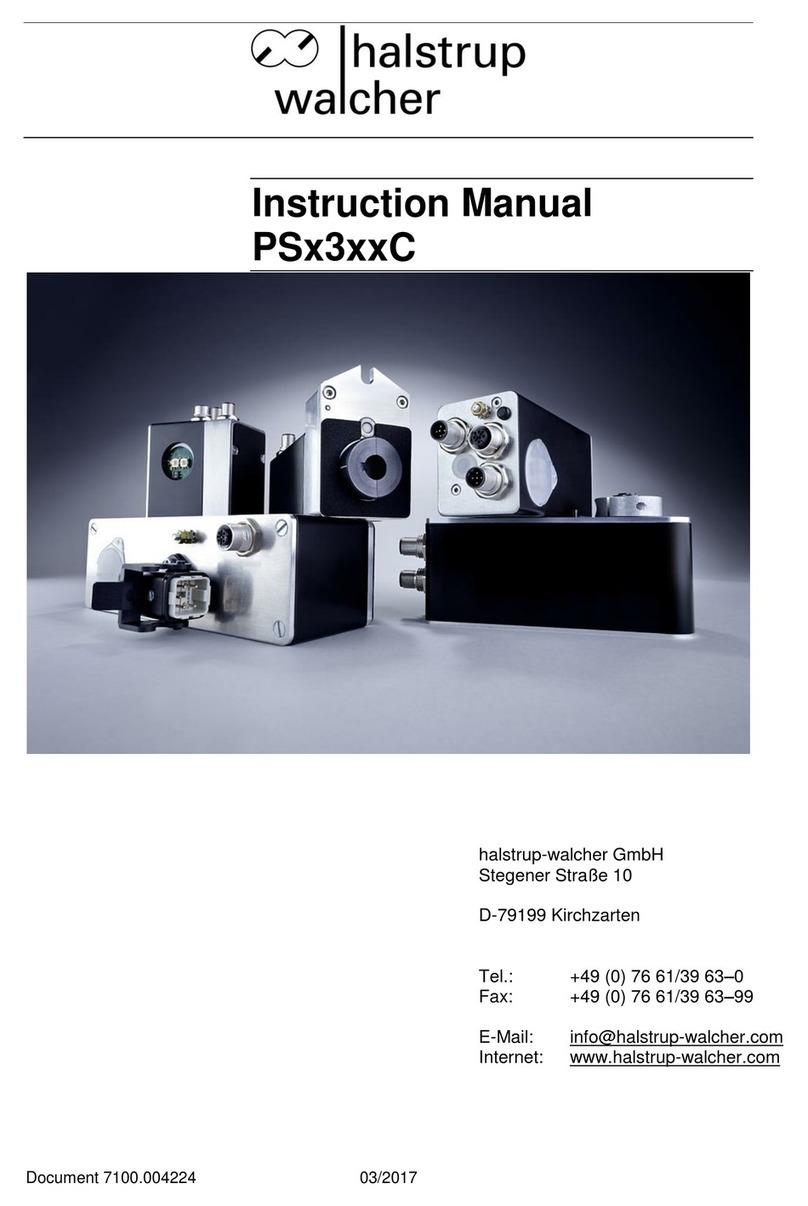
halstrup-walcher
halstrup-walcher PS*3**C series instruction manual

Westlock
Westlock ICOT 5400 Technical manual
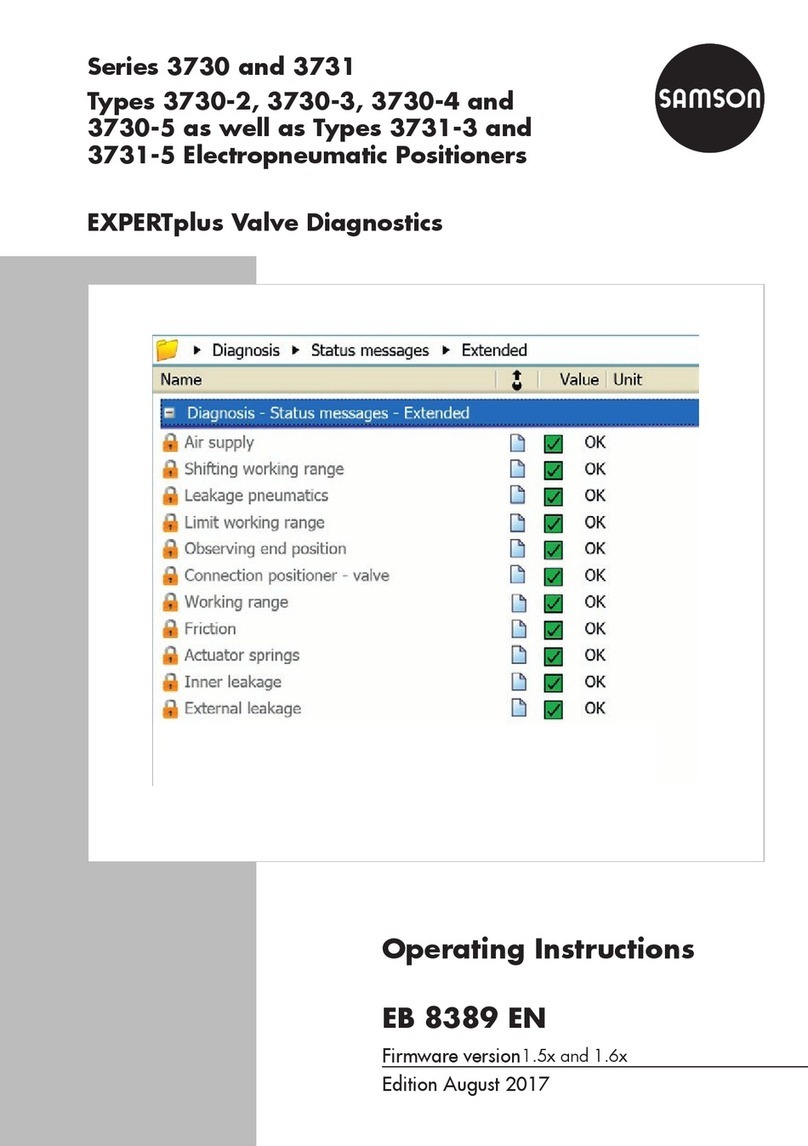
Samson
Samson TROVIS 3730-3 operating instructions
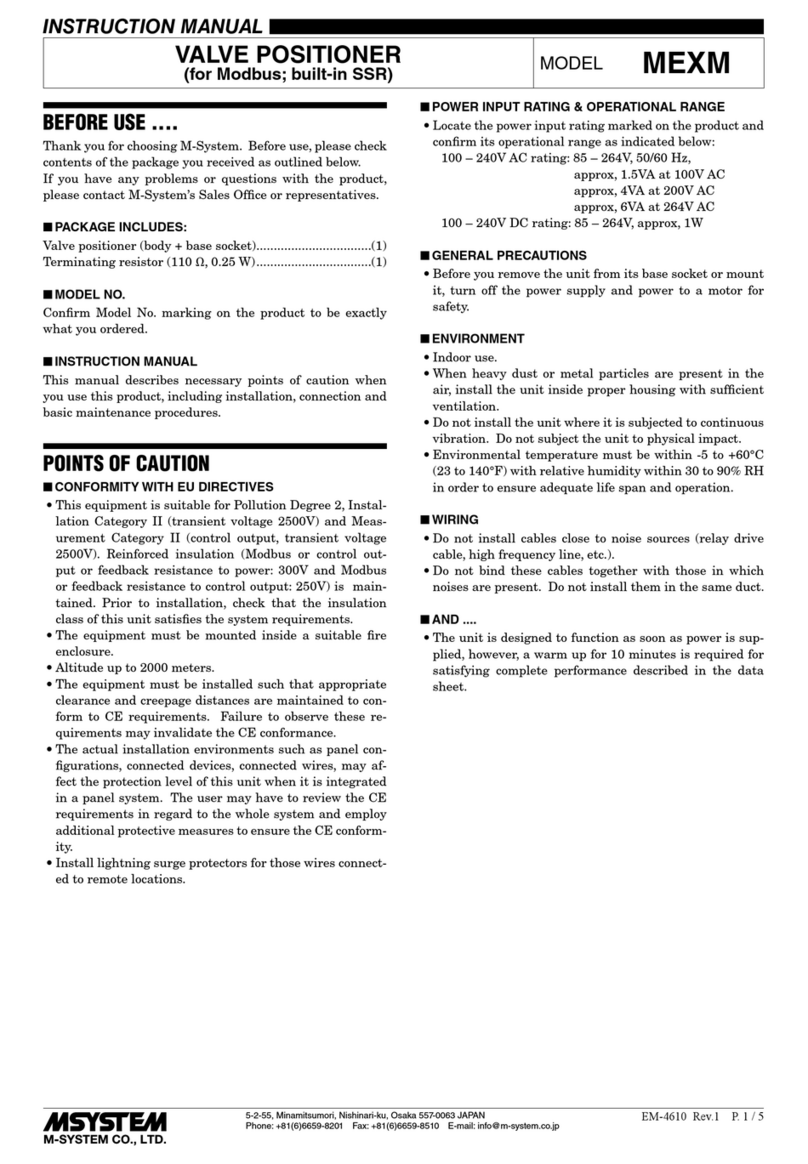
M-system
M-system MEXM instruction manual

